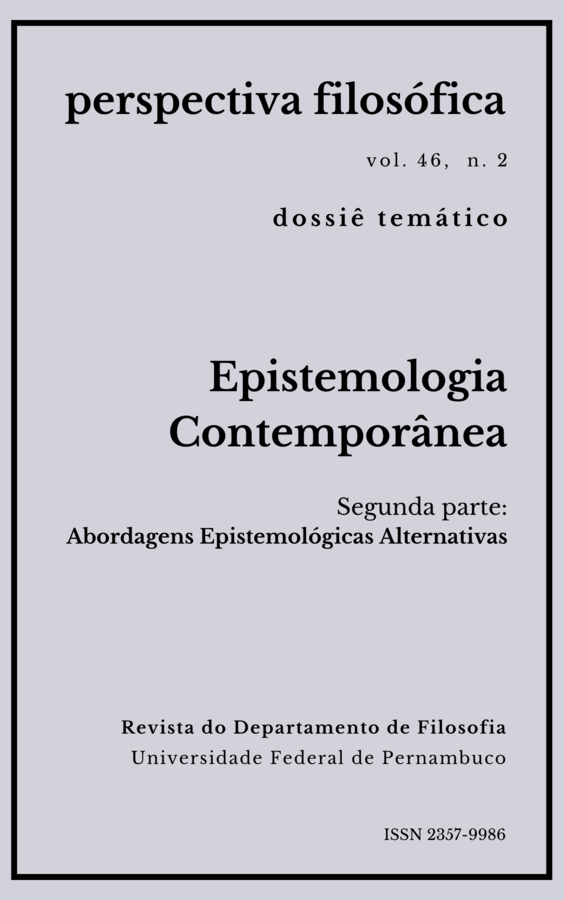Raciocínios analógicos: representacionalismo ou enativismo?
DOI:
https://doi.org/10.51359/2357-9986.2019.248071Palavras-chave:
Raciocínio analógico, representacionalismo, enativismo, modelosResumo
Raciocínios analógicos são tradicionalmente concebidos como processos que envolvem a comparação de representações mentais. Mais recentemente, com o surgimento de teorias não-representacionalistas da cognição humana, surge a questão de como explicar processos tradicionalmente concebidos como representacionais. Nesse contexto, levantamos a discussão sobre se representações mentais farão parte de uma explicação dos raciocínios analógicos, oferecendo um embate de perspectivas e tendo como principal objetivo o fomento do debate. Primeiramente, apresentamos a visão segundo a qual raciocínios analógicos são processos mentais representacionais. Em seguida, apresentamos alguns problemas levantados por Fodor para o seu tratamento computacional, mas sugerimos que esses problemas não afetam a ideia de que raciocínios analógicos envolvem representações mentais. Na seção seguinte, apresentamos a teoria enativista linguística e sugerimos a possibilidade de compatibilização dessa teoria com uma concepção de analogia enquanto processo de categorização não-representacional. Por fim, sintetizamos as duas propostas apresentadas e sugerimos que o contraste de perspectivas divergentes sobre capacidades cognitivas é especialmente frutífero para a nossa compreensão da mente.Referências
BARTHA, P. Analogy and analogical reasoning. In: ZALTA, E. (Ed.) TheStanford Encyclopedia of Philosophy. Spring 2019 Edition.<https://plato.stanford.edu/entries/reasoning-analogy>
BUTLIN, P. Representation and the active consumer. Synthese, Ahead ofprint version, 2018. <https://doi.org/10.1007/s11229-018-01941-9>
CARRUTHERS, P. The architecture of the mind: massive modularity andthe flexibility of thought. Oxford: Oxford University Press, 2006.
CARVALHO, E.; ROLLA, G. O desafio da integração explanatória para oenativismo: escalonamento ascendente ou descendente. Revista Prometheus,v. 33, p. 161-181, 2020.
DI PAOLO, E.; CUFFARI, E.; DE JAEGHER, H. Linguistic bodies: thecontinuity between life and language. Cambridge, MA: MIT Press, 2018.
FIGUEIREDO, N. M. Book review: DI PAOLO, Ezequiel, DE JAEGHER,Hanne & CUFFARI, Elena. Linguistic Bodies: The continuity between Lifeand Language. (MIT Press, 2018, 414 pages). Revista Manuscrito, v. 43, n.1, p. 151-170, 2020. <https://doi.org/10.1590/0100-6045.2020.v43n1.nf>
FODOR, J. A. The language of thought. Cambridge, MA: HarvardUniversity Press, 1975.FODOR, J. A. The modularity of mind: an essay on faculty psychology.Cambridge, MA: MIT Press, 1983.
FODOR, J. A. Psychosemantics: the problem of meaning in the philosophy of mind. Cambridge, MA: MIT Press, 1987.
FODOR, J. A. The mind doesn’t work that way: the scope and limits of computational psychology. Cambridge, MA: MIT Press, 2001.
FODOR, J. A. LOT 2: the language of thought revisited. Oxford: Oxford University Press, 2008. <https://doi.org/10.1093/acprof:oso/9780199548774.001.0001>
FORBUS, K. Exploring analogy in the large. In: GENTNER, D.; HOLYOAK, H.; KOKINOV, B. (Eds.) The analogical mind: perspectives from cognitive science. Cambridge MA: The MIT Press, 2001. p. 23-58.
GENTNER, D. Structure-mapping: a theoretical framework for analogy. Cognitive Science, v. 7, n. 2, p. 155-170, 1983. <https://doi.org/10.1207/s15516709cog0702_3>
GENTNER, D.; FORBUS, D. Computational models of analogy. Wiley Interdisciplinary Reviews: Cognitive Science, v. 2, n. 3, 266-276, 2011. <https://doi.org/10.1002/wcs.105>
HOFSTADTER, D. Analogy as the core of cognition. In: GENTNER, D.; HOLYOAK, H.; KOKINOV, B. (Eds.) The analogical mind: perspectives from cognitive science. Cambridge MA: The MIT Press, 2001. p. 499-538.
HOLYOAK, H.; GENTNER, D.; KOKINOV, B. Introduction: the place of analogy in cognition. In: GENTNER, D.; HOLYOAK, H.; KOKINOV, B. (Eds.) The analogical mind: perspectives from cognitive science. Cambridge MA: The MIT Press, 2001. p. 01-19.
HUFFERMANN, J.; NOGUEZ, P. Propostas enativas e a questão da continuidade entre formas de cognição. Revista Prometheus, v. 33, p. 209-229, 2020.
LAKE, B.; ULLMAN, T.; TENENBAUM, J.; GERCHMAN, S. Building machines that learn and think like people. Behavioral and Brain Sciences, v. 40, Artigo E253, 2017. <https://doi.org/10.1017/S0140525X16001837>
ORLANDI, N. The innocent eye: why vision is not a cognitive process. Oxford; New York: Oxford University Press, 2014. <https://doi.org/10.1093/acprof:oso/9780199375035.001.0001>
PINKER, S. So how does the mind work? Mind & Language, v. 20, n. 1, p. 01-24, 2005. <https://doi.org/10.1111/j.0268-1064.2005.00274.x>
RAMSEY, W. Must cognition be representational? Synthese, v. 194, n. 11, p. 4197-4214, 2015. <https://doi.org/10.1007/s11229-014-0644-6>
ROSH, E. Introduction to the revised edition. In: VARELA, F.; THOMPSON, E.; ROSCH, E. The embodied mind: cognitive science and human experience. Revised edition. Cambridge, MA: MIT Press, 2016. p. XXXV-LV.
SCHICKORE, J. Scientific Discovery. ZALTA, E. (Ed.) The Stanford Encyclopedia of Philosophy. Summer 2018 Edition. <https://plato.stanford.edu/entries/scientific-discovery>
SHAW, P. Logic and its limits. Oxford: Oxford University Press, 1997.
THAGARD, P. How scientists explain disease. Princeton: Princeton University Press, 2000.
THAGARD, P.; STEWART, T. The AHA! experience: creativity through emergent binding in neural networks. Cognitive Science, v. 35, n. 1, p. 01-33, 2011. <https://doi.org/10.1111/j.1551-6709.2010.01142.x>
VARELA, F.; THOMPSON, E.; ROSCH, E. The embodied mind: cognitive science and human experience. Revised edition. Cambridge, MA: MIT Press, 2016.
Downloads
Publicado
Edição
Seção
Licença
A Revista Perspectiva Filosófica orienta seus procedimentos de gestão de artigos conforme as diretrizes básicas formuladas pelo Conselho Nacional de Desenvolvimento Científico e Tecnológico (CNPq). http://www.cnpq.br/web/guest/diretrizesAutores que publicam nesta revista concordam com os seguintes termos:
Os autores mantém os direitos autorais e concedem à revista o direito de primeira publicação, sendo o trabalho simultaneamente licenciado sob https://creativecommons.org/licenses/by/4.0/deed.pt_BR que permite o compartilhamento do trabalho com reconhecimento da autoria e publicação inicial nesta revista.
Os autores têm autorização para assumir contratos adicionais separadamente, para distribuição não-exclusiva da versão do trabalho publicada nesta revista, com reconhecimento de autoria e publicação inicial nesta revista (Consultar http://opcit.eprints.org/oacitation-biblio.html).

Esta revista está licenciada com uma Licença Creative Commons Atribuição 4.0 Internacional.













